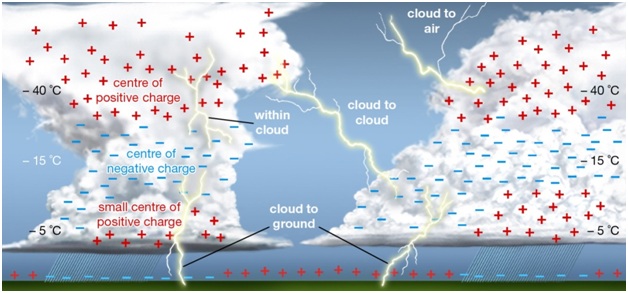Context
According to the Earth Networks India Lightning Report, 2019, lightning kills more people than cyclones in India and it could increase as much as 12% with every 1-degree increase in global warming.
- India sees 2,000-2,500 lightning deaths every year on average. Lightning is the biggest contributor to accidental deaths due to natural causes.
What are Lightning strikes?
- Lightning is a very rapid and massive discharge of electricity in the atmosphere, some of which is directed towards the Earth’s surface.
- These discharges are generated in giant moisture-bearing clouds that are 10-12 km tall.
- Base: The base of these clouds typically lies within 1-2 km of the Earth’s surface, while their top is 12-13 km away.
- Temperature: Temperatures towards the top of these clouds are in the range of minus 35 to minus 45 degrees Celsius.
The process
- Heating: As water vapour moves upward in the cloud, the falling temperature causes it to condense. Heat is generated in the process, which pushes the molecules of water further up.
- Formation of ice crystals: As they move to temperatures below zero degrees celsius, the water droplets change into small ice crystals.
- Fall: They continue to move up, gathering mass until they are so heavy that they start to fall to Earth. This leads to a system in which, simultaneously, smaller ice crystals are moving up and bigger crystals are coming down.
- Release of electrons: Collisions follow and trigger the release of electrons. As the moving free electrons cause more collisions and more electrons, a chain reaction ensues.
- Positive, negative charge: This process results in a situation in which the top layer of the cloud gets positively charged, while the middle layer is negatively charged.
- Flow of massive current: The electrical potential difference between the two layers is huge of the order of a billion to 10 billion volts. In very little time, a massive current, of the order of 100,000 to a million amperes, starts to flow between the layers.
- Heating of air column: An enormous amount of heat is produced, and this leads to the heating of the air column between the two layers of the cloud.
- This heat gives the air column a reddish appearance during lightning.
- Thunder: As the heated air column expands, it produces shock waves that result in thunder.

How does this current reach the Earth from the cloud?
- Earth is a good conductor of electricity and is electrically neutral.
- However, in comparison to the middle layer of the cloud, it becomes positively charged.
- As a result, about 15%-20% of the current gets directed towards the Earth as well.
- It is this flow of current that results in damage to life and property on Earth.
Why taller objects are more at risk?
- There is a greater probability of lightning striking tall objects such as trees, towers or buildings.
- Once it is about 80-100 m from the surface, lightning tends to change course towards these taller objects.
- This happens because air is a poor conductor of electricity, and electrons that are travelling through air seek both a better conductor and the shortest route to the relatively positively charged Earth’s
